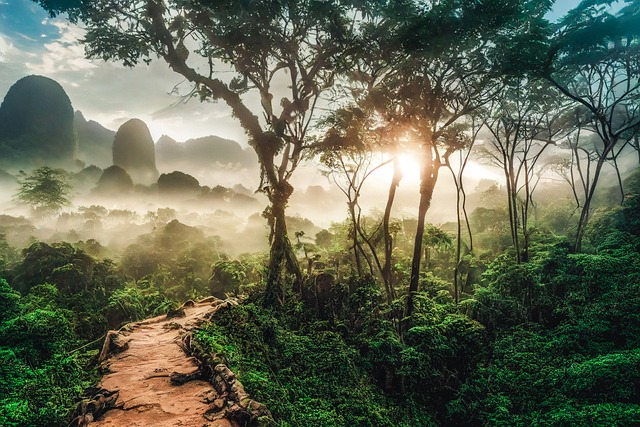The world's tropical rainforests are more than just lush landscapes teeming with life—they are vital to our survival and serve as a critical defense against climate change. These verdant giants, from the sprawling Amazon rainforest that spans nine South American countries to the dense jungles in Indonesia, are essential to human existence.

However, these rich ecosystems face significant threats from deforestation driven by mining, land-grabbing, animal grazing, and devastating wildfires. This destruction not only jeopardizes the intricate balance of our environment but also undermines our efforts to combat climate change. The United Nations has warned that the decisive battle to limit global warming will be fought and won or lost in this decade, making the protection of rainforests more crucial than ever.
The Indispensable Role of Rainforests
Carbon Sinks and Climate Regulators
Tropical rainforests cover approximately 1.2 billion hectares (3 billion acres) and act as one of the planet's largest carbon sinks. Trees absorb vast amounts of carbon dioxide and release the oxygen we breathe, sequestering about 7.6 billion metric tonnes of CO2 annually—about 1.5 times the United States' yearly emissions. This process helps mitigate the greenhouse effect, crucial for controlling global temperatures.
However, when forests are destroyed, they release stored carbon back into the atmosphere, exacerbating climate change. For instance, a severe drought in the Amazon in 2005 caused massive tree deaths, turning the forest into a net carbon emitter, surpassing the annual greenhouse gas emissions of Europe and Japan combined.
Biodiversity Hotspots
Rainforests are home to an astonishing array of biodiversity. Millions of plant and animal species, many yet to be discovered, thrive in these environments. The loss of forests not only threatens these species with extinction but also destabilizes entire ecosystems, affecting global biodiversity.
Water Cycle and Weather Patterns
Rainforests play a pivotal role in the global water cycle. Their dense canopies retain moisture, which is then released into the atmosphere as water vapor, driving rainfall patterns. This phenomenon is critical in regions such as South America, sub-Saharan Africa, and Southeast Asia, where rainforests help stabilize local climates, ensuring consistent rainfall and temperature regulation, essential for food and water security.
Livelihoods and Indigenous Cultures
Around 1.6 billion people, including nearly 70 million Indigenous people, depend on forest resources for their livelihoods. Rainforests provide food, medicine, and materials, sustaining diverse cultures and ways of life that have coexisted with these forests for centuries.
Natural Disaster Mitigation
Rainforests also serve as natural buffers against disasters. Their canopies intercept heavy rainfall, slowing its descent and reducing the impact on the soil below. This function helps prevent soil erosion, landslides, and flooding, protecting both the environment and human communities.
The stakes have never been higher. Protecting rainforests is not just about preserving nature's beauty; it's about safeguarding our planet's health and ensuring a sustainable future for generations to come. By understanding and acting on the vital role of rainforests, we can make informed choices to protect these irreplaceable ecosystems and the myriad benefits they provide to humanity and the Earth.
Small changes—such as incremental increases in global temperatures—trigger rapid, often irreversible transformations. Scientists warn that forest clearances and global warming may already have pushed the Amazon close to such a tipping point, risking its transformation from lush forest to savannah within decades.
The Fragility of Rainforest Ecosystems
When humans degrade rainforests by removing trees, the altered canopy allows more sunlight to penetrate, changing the temperature and overall conditions of the ecosystem. This can set off a chain reaction of negative impacts.
In 2018, climatologists Carlos Nobre and Thomas Lovejoy estimated that preserving between 75% and 80% of the Amazon forest is crucial to prevent parts of it from becoming a drier, savannah-like ecosystem. Over the past two decades, the Amazon's ability to recover from extended droughts has diminished, damaging its complex ecosystem and pushing it closer to a potential tipping point. A study published in Nature Climate Change in 2022 indicated that three-quarters of the rainforest has been losing its resilience to shocks such as droughts and fires, struggling to return to a healthy state.
Tipping points might have already been reached in parts of Brazil's southeastern Amazon region, where some areas now emit more carbon than they absorb. This alarming trend was highlighted in a 2021 study published in Nature.
Drivers of Deforestation
Agriculture and Grazing
Deforestation is driven largely by the need to clear land for agriculture and grazing. In the Amazon, which holds about half of the world's remaining tropical forest area, most deforested land is converted to cattle pastures, followed by soy fields. Brazil, the world's second-largest beef supplier, increasingly feeds its cattle herds on pastures created by deforestation in the Amazon.
Land-Grabbing and Illegal Activities
Land-grabbing, often orchestrated by organized crime gangs, is another key driver of deforestation. This phenomenon, known as "narco-deforestation," has been particularly destructive in Colombia, Peru, Brazil, and Bolivia. Research indicates that illegal land speculation, not just food production, plays a significant role in deforestation. Traffickers use drug profits to buy forest land, which is then turned into cattle pastures.
Illegal gold mining also contributes significantly to deforestation across the Amazon. In Peru and Colombia, the cultivation of coca, the raw ingredient for cocaine, further exacerbates forest loss.
Palm Oil Production
In Indonesia, home to a third of the world's rainforests, deforestation is often linked to land clearing for palm oil production. As the world's largest palm oil producer and exporter, Indonesia's palm oil industry poses a significant threat to its tropical forests.
Wildfires and Climate Change
Tropical forests are increasingly prone to destructive wildfires as global warming creates hotter, drier conditions that fuel larger blazes. These fires can cause extensive damage, further pushing rainforests toward their tipping points.
The Urgent Need for Action
The evidence is clear: rainforests are teetering on the brink of catastrophic changes. Immediate and concerted efforts are required to halt deforestation and restore degraded lands. Protecting these vital ecosystems is not only crucial for maintaining global biodiversity but also for mitigating climate change and preserving the myriad ecological services that rainforests provide. By addressing the root causes of deforestation and enforcing sustainable practices, we can safeguard the future of our planet's most precious natural resources.
Global tropical forest loss saw a slight decline of 9% in 2023 compared to 2022. Despite this reduction, the destruction of the world's rainforests remains alarmingly high, according to research published by Global Forest Watch in April.
The Scope of Forest Loss
In 2023, approximately 37,000 square kilometers (14,000 square miles) of primary forests—those untouched by human activity, often referred to as old-growth forests—were lost. This area is nearly the size of Switzerland and larger than the US state of Maryland.
Regional Trends in Deforestation
Brazil and Colombia
Primary forest loss in Brazil and Colombia saw significant declines between 2022 and 2023, dropping by 36% and 49% respectively. These reductions are promising but were largely negated by increases in deforestation elsewhere.
Laos and Nicaragua
Deforestation surged sharply in countries such as Laos and Nicaragua, offsetting the progress made in Brazil and Colombia.
Democratic Republic of Congo
In the Democratic Republic of Congo, forest destruction remained relatively stable but persistently high at around 5,000 square kilometers (1,930 square miles).
Bolivia
Bolivia experienced a 27% increase in forest loss, primarily driven by agricultural activities such as soy expansion and fires caused by land clearing for cattle grazing and crops.
Global Efforts and Challenges
In 2021, over 140 countries committed to ending deforestation by the end of the decade. However, Global Forest Watch reports that the world is far off track, with deforestation trends moving in the wrong direction.
Despite some regional successes in reducing deforestation, the global picture remains dire. Coordinated international efforts, stricter enforcement of environmental regulations, and sustainable land management practices are essential to halt and reverse forest loss. Protecting primary forests is critical not only for preserving biodiversity but also for combating climate change and maintaining the ecological balance necessary for human survival.


